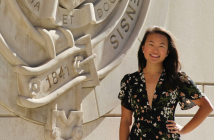Early in his campaign for president, Republican nominee Donald Trump proposed to bar all Muslims from entering the United States. More recently he has called for the administration of an ideological test to would-be immigrants. To many, these proposals plainly appear to violate the Constitution.
Yet, if the New York real estate tycoon/TV celebrity becomes president next January and implements these policies, the Supreme Court may well uphold them, due to a 127-year-old immigration doctrine still in effect, said Fordham Law Professor Jennifer Gordon, an immigration law expert.
The doctrine began with the Chinese Exclusion Case in 1889. The Supreme Court held that, because the power to control who enters the country is rooted in our country’s sovereignty and ability to conduct foreign affairs, it is only Congress and the president—the “political branches”—that can make immigration policy. Further invoking national security fears at the time, the Court went on to hold that immigration policies are not subject to the usual judicial checks and balances.
As a result of this plenary power doctrine, the Supreme Court has never struck down a rule about the requirements for entry to the United States, even if it in any other context would be held to violate due process, equal protection, or the First Amendment. Thus, a hypothetical President Trump could suspend the right of any group of people to enter the United States based on their nationality or religion.
“Trump’s immigration proposals force us to face the consequences of the plenary power doctrine: it allows immigration policies that explicitly violate our Constitution,” Gordon said, noting Trump’s Democratic opponent, Hillary Clinton, has said nothing that would elicit comparable concern.
Gordon is currently working on a law review article that clears a path to bringing immigration law back into the realm of constitutional review. She argues that, rather than rely on the sovereignty and foreign affairs powers (neither of which are enumerated in the Constitution), the Supreme Court should re-root the immigration power in the Commerce Clause of the Constitution.
For almost 50 years before the Chinese Exclusion Case, Gordon noted, the Court attributed the immigration power to the Commerce Clause. A return to this position, she contends, would open the door to review of immigration policies for constitutionality.
An immigration power tied to the Commerce Clause would still allow the president and Congress special powers should a genuine national security threat arise. However, most immigration issues relate to workaday issues far from the purview of national security.
“There’s no reason that most immigration policies should be exempted from the ordinary rule that laws made by Congress and the policies of the executive branch are reviewed by the courts for their constitutionality,” Gordon said.
Gordon’s article advances historical and legal arguments for advocates and federal courts to consider. The Supreme Court itself would ultimately need to change the immigration doctrine, she noted.
While Trump has at times appeared to back away from a Muslim ban, and has not offered any policy specifics on how to administer such an action, the core of his policy remains clear.
If he had said that Muslim children will be barred from public schools, nobody would doubt that his proposal was in conflict with the Constitution’s guarantee of religious freedom,” Gordon said, noting such a policy would plainly violate the First Amendment. “Instead, he’s saying he won’t let Muslim people into the country. It should be viewed exactly the same way—but because it’s an immigration policy and falls under the plenary power doctrine, it might well be upheld.”
Trump’s rhetoric represents one wave of anti-immigrant sentiment among many that have crested during various points throughout American history.
The Chinese Exclusion Act in the 1880s, for instance, sought to ban Chinese immigration after Chinese railroad workers finished building the transcontinental railroad in the United States. In considering the legality of the act, the Supreme Court described the presence of Chinese immigrants in the United States as “approaching the character of an Oriental invasion” and characterized Chinese people as “obnoxious” and likely to lie, in keeping with the explicit anti-Chinese sentiment of the day, Gordon noted.
The plenary power doctrine’s continued application for immigration matters increases the likelihood that it will be used when anti-immigrant opinions are strongest, the professor said.
There have been cracks in the plenary power doctrine before, including three months before 9/11, when the Supreme Court ruled in the Zadvydas case that the plenary power doctrine did not empower the United States to indefinitely detain immigrants under order of deportation whom no other country will accept. In the aftermath of 9/11, however, the Supreme Court resumed its reliance on the plenary power doctrine in the 2003 case of Demore v. Kim.
While some scholars argue that the Court is turning away from the doctrine without overruling it, Gordon remains concerned.
“Unless the Supreme Court explicitly changes direction, the plenary power doctrine will remain available for the Court to rely on any time it wishes to uphold an immigration policy that is inconsistent with the Constitution,” Gordon said.




